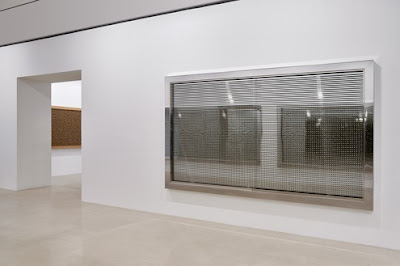 |
| Damien Hirst, Cathedrals Built on Sand Installation View @ Gagosian |
Popular wisdom would have us believe that Damien Hirst is all sparkle and no substance. It's just visual candy, as one critic put it in 1993 when Hirst burst onto the contemporary art scene. Critics love to tell us that his work is superficial, mass cultural trash. I have never understood this estimation, and always wonder if these same critics have ever been face to face with these conceptually complex and aesthetically gorgeous art works? If ever anyone was in any doubt about the value of Hirst's sculpture, the current exhibition at Gagosian's rue de Ponthieu gallery will surely convince that this is contemporary art at its most sophisticated.
 |
| Damien Hirst, Cathedrals Built on Sand Installation View @ Gagosian |
The exhibition features pill cabinets made between 1996 and 2021. Row upon row of candy coloured pills—it's that candy reference yet again—in cabinets with mirrored backs and locked sliding glass cases. As if these objects were precious paintings, they are perfectly framed in shiny, mirrored aluminium. From the start, I couldn't decide if I was being plunged into the pill aisle at Rite Aid or a gallery filled with priceless art works. The mirrored display cabinets, lighting, reflections and all those candy-look alike pills can be found in both contexts. The cabinets also seem to be indicating that as the ultimate consumers, there is nothing more tempting than our own image. We watch ourselves in the mirrored backings, however, our faces and features are blurred. Our figures studded with pills and our vision is made foggy, as if we are under the influence of a mixture of pills.
The pills themselves are mesmerising. We move up close to study them on their shelves, and our perception shifts from looking at an art work to studying pills (many of which are fabricated in Hirst's studio). Then, as we start to recognize some and wonder about others, our salivary glands are activated. They look so delicious that we want to pop them into our mouths, and enjoy their flavour. This is, of course, the problem. The works discourse on the pharmaceutical industry, our dependence on pills, the ease of access, that feeling of gratification when swallowed. All of these thoughts are aroused by looking at the pills on their shelves. And because the lighting is designed to arouse our desire to buy, the works are as much about shopping as they are about popping pills. The title of the exhibition reminds us of the impossibility of filling the emptiness of these desires. Our hope and hunger to escape through pills is sure to remain unsatiated when consuming from these Cathedrals Built on Sand.
 |
| Damien Hirst, When the Heart Speaks, 2005 |
As is the case with Hirst's animals in formaldehyde, the pills on shelves in glass cabinets explore notions of aesthetics. As much as the works are about the pharmaceutical industry, our insatiable desire to be fixed with a pill, they are also about the art industry. The sparkling frame and shining object on the gallery wall makes them gorgeous to look at. They are precisely the eye candy that Hirst has been accused of producing. But they are much more. The cabinets are aesthetically pleasing, addressing us on an intellectual, visual, emotional and physical level as we are pulled towards and away from them, drawn into their spell, to wonder at the meticulous detail of their making and as we try to get a better glimpse of ourselves. Each work asks something different of the viewer: some create intense confusion as we are tempted to find patterns in the layout of the pills on their shelves. Others are best viewed from a distance, like cabinets of curiosity filled with once living beings now dead and stuffed.
The cabinets also engage the ongoing tensions between industrialization of art and culture as opposed to the hand made art work. The stainless steel cabinets are industrially produced, and of course, the pills are supposed to be industrially produced. But many of them are made individually by hand in Hirst's studio - itself a form of the manufacture of art.
 |
| Damien Hirst, Cathedrals Built on Sand Installation View @ Gagosian |

No comments:
Post a Comment